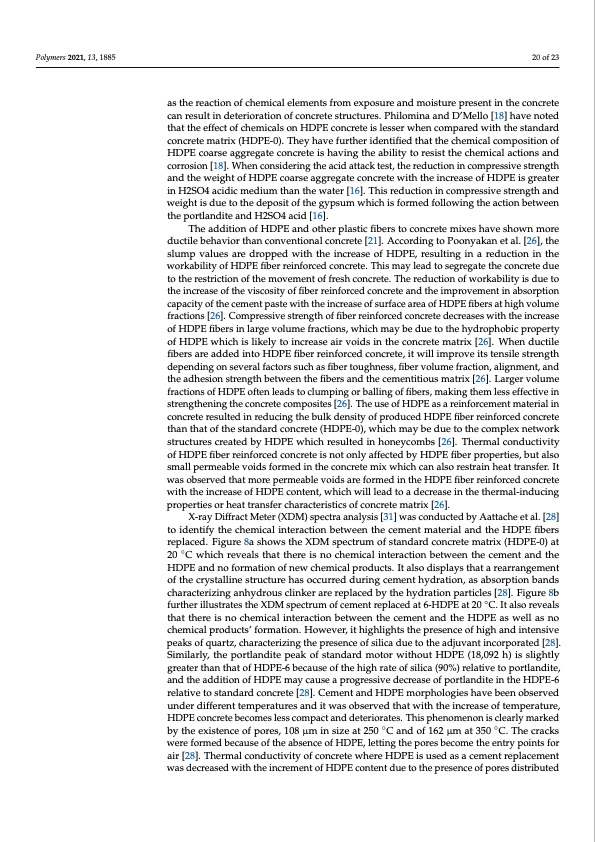
PDF Publication Title:
Text from PDF Page: 020
Polymers 2021, 13, 1885 20 of 23 as the reaction of chemical elements from exposure and moisture present in the concrete can result in deterioration of concrete structures. Philomina and D’Mello [18] have noted that the effect of chemicals on HDPE concrete is lesser when compared with the standard concrete matrix (HDPE-0). They have further identified that the chemical composition of HDPE coarse aggregate concrete is having the ability to resist the chemical actions and corrosion [18]. When considering the acid attack test, the reduction in compressive strength and the weight of HDPE coarse aggregate concrete with the increase of HDPE is greater in H2SO4 acidic medium than the water [16]. This reduction in compressive strength and weight is due to the deposit of the gypsum which is formed following the action between the portlandite and H2SO4 acid [16]. The addition of HDPE and other plastic fibers to concrete mixes have shown more ductile behavior than conventional concrete [21]. According to Poonyakan et al. [26], the slump values are dropped with the increase of HDPE, resulting in a reduction in the workability of HDPE fiber reinforced concrete. This may lead to segregate the concrete due to the restriction of the movement of fresh concrete. The reduction of workability is due to the increase of the viscosity of fiber reinforced concrete and the improvement in absorption capacity of the cement paste with the increase of surface area of HDPE fibers at high volume fractions [26]. Compressive strength of fiber reinforced concrete decreases with the increase of HDPE fibers in large volume fractions, which may be due to the hydrophobic property of HDPE which is likely to increase air voids in the concrete matrix [26]. When ductile fibers are added into HDPE fiber reinforced concrete, it will improve its tensile strength depending on several factors such as fiber toughness, fiber volume fraction, alignment, and the adhesion strength between the fibers and the cementitious matrix [26]. Larger volume fractions of HDPE often leads to clumping or balling of fibers, making them less effective in strengthening the concrete composites [26]. The use of HDPE as a reinforcement material in concrete resulted in reducing the bulk density of produced HDPE fiber reinforced concrete than that of the standard concrete (HDPE-0), which may be due to the complex network structures created by HDPE which resulted in honeycombs [26]. Thermal conductivity of HDPE fiber reinforced concrete is not only affected by HDPE fiber properties, but also small permeable voids formed in the concrete mix which can also restrain heat transfer. It was observed that more permeable voids are formed in the HDPE fiber reinforced concrete with the increase of HDPE content, which will lead to a decrease in the thermal-inducing properties or heat transfer characteristics of concrete matrix [26]. X-ray Diffract Meter (XDM) spectra analysis [31] was conducted by Aattache et al. [28] to identify the chemical interaction between the cement material and the HDPE fibers replaced. Figure 8a shows the XDM spectrum of standard concrete matrix (HDPE-0) at 20 ◦C which reveals that there is no chemical interaction between the cement and the HDPE and no formation of new chemical products. It also displays that a rearrangement of the crystalline structure has occurred during cement hydration, as absorption bands characterizing anhydrous clinker are replaced by the hydration particles [28]. Figure 8b further illustrates the XDM spectrum of cement replaced at 6-HDPE at 20 ◦C. It also reveals that there is no chemical interaction between the cement and the HDPE as well as no chemical products’ formation. However, it highlights the presence of high and intensive peaks of quartz, characterizing the presence of silica due to the adjuvant incorporated [28]. Similarly, the portlandite peak of standard motor without HDPE (18,092 h) is slightly greater than that of HDPE-6 because of the high rate of silica (90%) relative to portlandite, and the addition of HDPE may cause a progressive decrease of portlandite in the HDPE-6 relative to standard concrete [28]. Cement and HDPE morphologies have been observed under different temperatures and it was observed that with the increase of temperature, HDPE concrete becomes less compact and deteriorates. This phenomenon is clearly marked by the existence of pores, 108 μm in size at 250 ◦C and of 162 μm at 350 ◦C. The cracks were formed because of the absence of HDPE, letting the pores become the entry points for air [28]. Thermal conductivity of concrete where HDPE is used as a cement replacement was decreased with the increment of HDPE content due to the presence of pores distributedPDF Image | Engineering Performance of Concrete Incorporated with Recycled HDPE

PDF Search Title:
Engineering Performance of Concrete Incorporated with Recycled HDPEOriginal File Name Searched:
6b2d9750f7cf13ccb459f476e519aec39ce1.pdfDIY PDF Search: Google It | Yahoo | Bing
Development of a solar powered Electric Ship The Electricship website originally started off as a project to develop a comprehensive renewable, affordable, modular electric ship... More Info
Modular Boat Hull Composite The case for a unsinkable, modular composite hybrid boat hull... More Info
MS Burgenstock Hybrid Electric Catamaran Lake Lucerne Unique shuttle servicing Lucerne to the Burgenstock Resort... More Info
Ground Power Unit GPU Powered by Lithium Ion Batteries The goal of the Ground Power Unit is to provide a readily accessible, modular, ready-to-power solution for remote power... More Info
| CONTACT TEL: 608-238-6001 Email: greg@electricship.com | RSS | AMP |